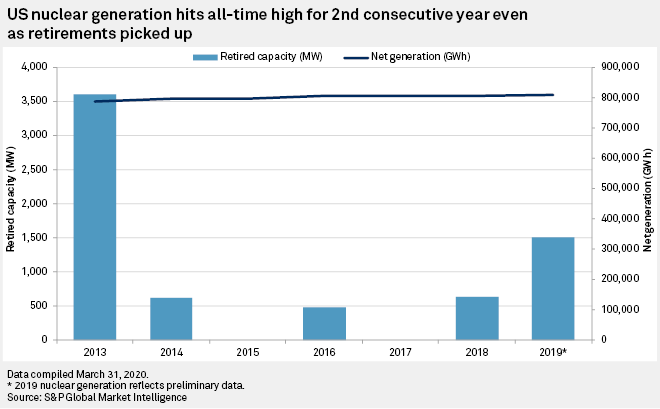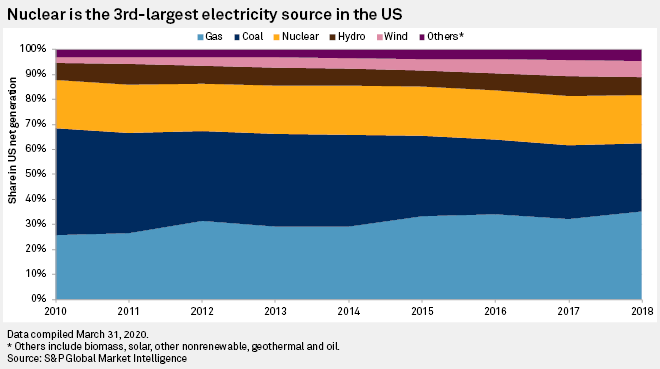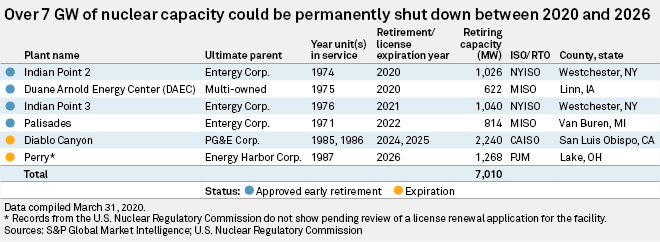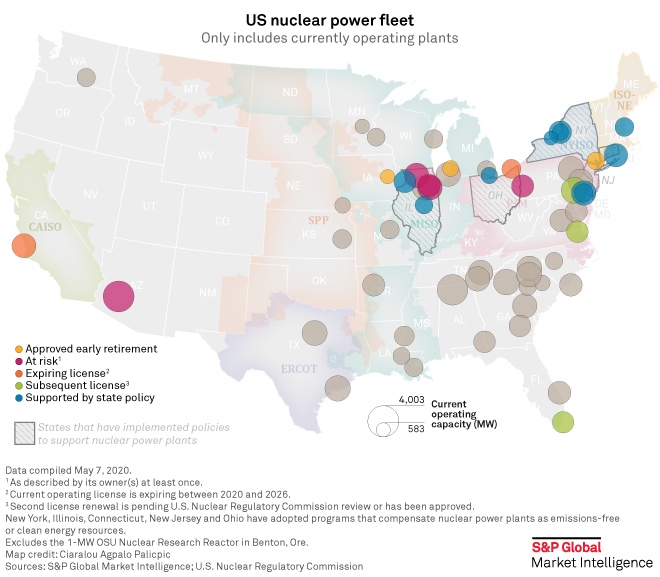The first of two remaining operating units at the Indian Point nuclear plant in New York shut down for good April 30, marking a continuation of reactors closing before their licenses run out.
The 1,026-MW Indian Point 2 had operated since August 1974 and was licensed through August 2024. But owner Entergy Corp. said in 2017 that it would shutter both units at the facility, citing low energy commodity prices.
The Indian Point closure continues a trend of premature retirements primarily due to economic pressure as the resource has struggled to compete in competitive markets against cheaper gas-fired generation. Between 2013 and 2019, nine nuclear generating units with a combined capacity of 6,850 MW have shuttered ahead of their license expirations. Of the nuclear capacity retired over this period, more than half, or roughly 3,600 MW, was shuttered in 2013 alone, though two of those plants were closed because of operational problems, not market conditions.
Retirements slowed in subsequent years, with none in 2015 or 2017, but picked up in 2019 with the shutdown of Exelon Corp.'s 829-MW Three Mile Island facility in Pennsylvania and Entergy's 685-MW Pilgrim Nuclear Power Station in Massachusetts.

Despite the recent plant retirements, U.S. nuclear generation has managed to remain elevated. After reaching an all-time high in 2018 at 807.1 million MWh, U.S. nuclear generation is once again poised to breach records as preliminary data for 2019 pegs annual net generation at 809.4 million MWh.
Nuclear has been the third-largest source of electricity in the U.S., powering roughly 20% of the nation's electricity each year from 2010 to 2018, the latest year for which annual generation figures are available. It was bested only by natural gas- and coal-fired generation.

Ninety-five commercial nuclear generating units are operating in the U.S. with a combined capacity of 99,251 MW. But more nuclear units are slated to close through the middle part of the decade due to license expiration or premature retirement.

The retirements of Entergy's Indian Point 2, the 1,040-MW Indian Point 3 in New York and the 814-MW Palisades plant in Michigan that will happen through 2022 are a part of the company's campaign to divest unregulated nuclear plants as it transitions to a pure-play utility model. Entergy's regulated utilities own four nuclear plants with five units in Arkansas, Louisiana and Mississippi.
The 622-MW Duane Arnold Energy Center (DAEC) is also slated for premature retirement in October. Though the facility is licensed to operate until 2034, majority-owner NextEra Energy Inc. subsidiary NextEra Energy Resources LLC shifted up the retirement date as the plant's power purchase contract is set to be terminated early.
Nuclear plants were originally granted 40-year operating licenses for their facilities, and starting the late 1990s, operators began applying to the U.S. Nuclear Regulatory Commission for an initial 20-year extension. The most recent initial extension, granted in March 2019, was to NextEra's Seabrook plant in New Hampshire. Not including Indian Point, six plants have shut down after receiving a license renewal but before the extension expired. Dominion Energy Inc., for example, shut its Kewaunee plant in Wisconsin in 2013, a little more than two years after receiving the license extension.
The NRC expects applications for initial license extensions at two plants by 2024. Also, two new units at the Alvin W. Vogtle Nuclear Plant in Georgia are expected to be in service by late 2022, adding more than 2,200 MW of capacity. The development is being led by Southern Co., and if the plants begin running, they would mark the first new nuclear plants in the U.S. since the Tennessee Valley Authority's Watts Bar Nuclear plant in Tennessee started up. Watts Bar Unit 1 began operating in 1996 and Unit 2 began operating in 2016. Construction on Unit 2 began in the 1970s and was abandoned in 1985. The TVA revived the project in 2007, retrofitting and updating parts that had already been built.
PG&E Corp. in 2009 applied to renew the operating licenses of its Diablo Canyon units 1 and 2 in California, which have a combined capacity of 2,240 MW, but withdrew the application in 2018 following a settlement agreement with groups including environmental advocates under which the company said it would replace the capacity with sources including renewables and energy storage. The two units will run through the duration of their current operating licenses, to 2024 and 2025.
The operating license for Energy Harbor Corp.'s 1,268-MW Perry facility in Ohio is set to expire in 2026. The facility had been slated for retirement in 2021, but the deactivation notice was withdrawn after Ohio passed legislation assisting the plant. According to the NRC, the company, through a previous owner, notified the commission in 2018 that it would not be submitting a license renewal application.

Citing unfavorable market conditions, nuclear plant operators in several states have warned that their facilities were at risk of being shut down. Since then, legislators in Illinois, New Jersey, New York and Ohio have provided some form of ratepayer-backed financial support for certain plants. In Connecticut, a law let Dominion's Millstone nuclear plant bid for a long-term power supply contract, leading to a 10-year deal under which two in-state utilities will purchase power from the plant.
Energy Harbor's 1,872-MW Beaver Valley plant in Pennsylvania had been slated for deactivation in 2021, but the company reversed that decision in March, primarily because of a plan by Gov. Tom Wolf for the state to join the Regional Greenhouse Gas Initiative. Should the governor's plan not come to fruition, Energy Harbor has said it would revisit its reversal.




